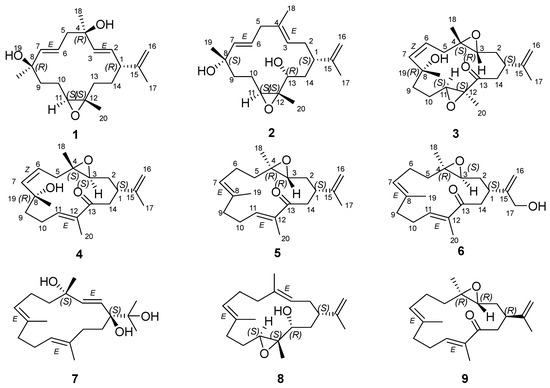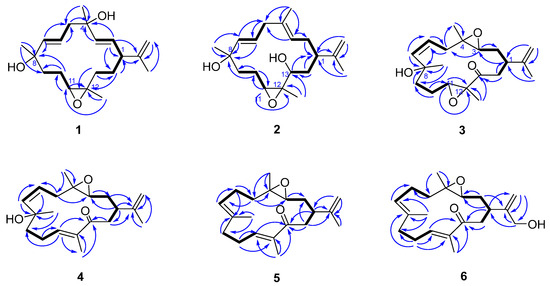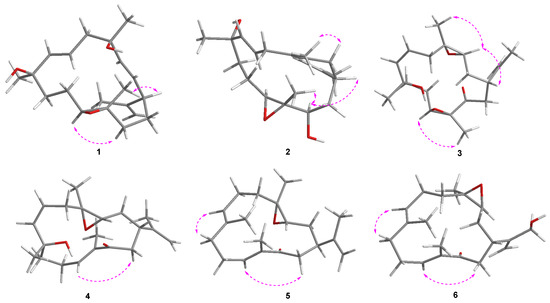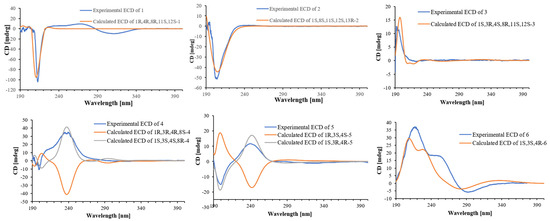Abstract
This research explored the chemical composition of the soft coral Sarcophyton sp., leading to the discovery of six previously unreported cembranoids, sarcophynoids D–I (1–6), and three known analog compounds (7–9). Structural elucidation of the new metabolites was achieved by spectroscopic methods, including one- and two-dimensional (1D and 2D) NMR (COSY, HSQC and HMBC), high-resolution electrospray ionization mass spectrometry (HRESIMS), quantum mechanical NMR (QM-NMR) methods, electronic circular dichroism (ECD) calculations, and comparison with literature data. All isolated substances were screened for antibacterial activities, and most exhibited moderate inhibitory effects against six pathogenic bacterial strains, with MIC values between 8 and 64 μg/mL. In addition, the effects of these compounds on LPS and IFN-γ stimulated RAW264.7 cells, focused on the release of NO and TNF-α, were also evaluated, but were inactive at 20 μM.
1. Introduction
The genus Sarcophyton, a highly prevalent group of soft corals, is widely recognized as a prolific source of biologically active secondary metabolites [1,2]. Natural products derived from species within this genus exhibit substantial chemical diversity, particularly enriched in terpenoid classes such as cembrane-type diterpenes, tetraterpenes, triterpenes, and ceramides, alongside steroids, sesquiterpenes, and fatty acids [3].
Structurally, cembrane diterpenoids possess a 14-membered isoprenoid macrocyclic backbone characterized by an isopropyl group at C-1 and methyl groups located at C-4, C-8, and C-12 (Figure 1). The basic structure of this diterpene usually presents cyclic ether, lactone, or furan moieties around the macrocyclic ring. Due to extensive functional group variation, including lactone, epoxide, furan, ester, aldehyde, hydroxyl, and carboxyl moieties, as well as cyclization diversity, cembrane diterpenoids can be categorized into several subclasses, including simple cembranes, cembranolides, furanocembranoids, and biscembranoids [4]. The 14-membered carbocyclic nucleus of cembranolides is often bonded to a lactone ring with five, six, seven, or eight members [4]. Furanocembranoids feature a furan heterocycle and a 14-membered carbocyclic nucleus. Additionally, they include a butenolide moiety that includes C-10, C-12, and C-20. Biscembranoids have a tricyclic backbone of tetraterpenoids with 14–6–14 members. These compounds demonstrate a wide spectrum of biological activities, such as anti-cancer, neuroprotective, antimicrobial, antiviral, antidiabetic, antifouling, and anti-inflammatory effects [3,5,6].

Figure 1.
Chemical structures of compounds 1–9.
In our continuous investigation of marine-derived bioactive compounds [7,8,9], we collected specimens of Sarcophyton sp. from the Xisha Islands. This study details the purification and structural characterization of six newly discovered cembranoids, designated as sarcophynoids D–I (1–6), along with three previously identified analogs (7–9) (Figure 1). Their antibacterial and anti-inflammatory properties were evaluated.
2. Results
The acetone extract of the title animals was partitioned between Et2O and H2O. The Et2O-soluble portion of the acetone extracts yielded the purified compounds 1–9 (Figure 1). The known compounds were identified as crassumol A (7) [10], 5-episinuleptolide (8) [11], and arbolide C (9) [12].
Sarcophynoid D (1) was obtained as a colorless oil. Its molecular formula, C20H32O3, was established through HRESIMS, which exhibited an ion peak at m/z 303.2325 [M − H2O + H]+ (calculated 303.2324), indicating five degrees of unsaturation. Analysis of the 13C NMR and HSQC data suggested the presence of 20 carbon signals, including three double bonds, three nonprotonated sp3 carbons, two methine carbons, five methylene carbons, and four methyl groups. The planar framework of 1 was established by 2D NMR correlation analysis (Figure 2). The 1H–1H COSY correlations of H2-13/H2-14/H-1/H-2/H-3, H-1/H-2/H-3, H2-5/H-6/H-7, and H2-9/H2-10/H-11 revealed three partial structures. These data, in combination with the crucial HMBC from H-2, H-3, H2-5, and H3-15 to C-4, from H-6, H-7, H2-10, and H3-19 to C-8, from H-11, H2-13, H2-14, and H3-17 to C-12, and from H-1, H-2, H-3, H2-16, and H3-17 to C-15, established the skeleton of 1. A comparison of the 1D and 2D NMR spectral data for compound 1 (Figure 2) with those of (1S,2E,4R,6E,8R,11S,12S)-11,12-epoxy-2,6-cembrane-4,8-diol, a naturally occurring cembrane derived from Australian Sarcophyton sp., revealed that they possess the same planar structure [13]. The difference was the existence of the Δ15,16 double bond of compound 1. The larger coupling constants (J2,3 = 15.7 Hz, and J6,7 = 15.6 Hz) supported the E configurations of the Δ2,3 and Δ6,7 double bonds. As reported by Quinn’s work, the change in configuration at C-8 is clearly reflected by the 13C chemical shift of the Me-19 group (27.8 ppm in 8S and 30.9 ppm in 8R), which suggested the 8R configuration of compound 1. The chemical shifts around the epoxide at C-11 and C-12 also suggested that this functional group should have the 11S,12S configuration. The 1D NOE correlation from H-13b (δH 1.01) to H-11, from H3-20 to H-1, together with the absence NOEs of H-11/H3-20, H-13b/H-1 and H-13b/H3-20, indicated that H-13b and H-11 were oriented toward the same face, relative to H-1 and H3-20 (Figure 3). Together with the quantum mechanical NMR (QM-NMR) approach [14,15], was applied to assign the relative configurations at C-1, C-4, C-8, C-11 and C-12. Four possible configurations were calculated: 1a (1R,4S,8R,11S,12S) and 1b (1R,4R,8R,11S,12S) (Figure S10). The computational and experimental data were correlated using the DP4+ procedure, and the relevant DP4+ probabilities were calculated [14,15]. According to Figure S10, configuration 1b showed a dominating probability, indicating that the relative configuration of 1 is (1R*,4R*,8R*,11S*,12S*). Ultimately, the absolute configuration of 1 was determined as 1R,4R,8R,11S,12S through time-dependent density functional theory (TDDFT) ECD calculations [16,17] (Figure 4).

Figure 2.
1H-1H COSY and key HMBC correlations of compounds 1–6.

Figure 3.
Key 1D NOEs of compounds 1–6.

Figure 4.
Calculated and experimental ECD data of compounds 1–6.
Sarcophynoid E (2) was isolated as a colorless oil and shared the same molecular formula as 1. A comparison of the 1D NMR spectra of compounds 2 and 1 indicated that they possess similar structural groups, with the primary differences being the position of the double bonds, the presence of one more sp3 oxygenated methine carbon, and one less sp3 oxygenated quaternary carbon in 2. The structure and assignments were further validated through 2D-NMR experiments. The E geometry of the Δ3,4 and Δ6,7 double bonds in compound 2 was corroborated by 1D NOE data and a larger coupling constant (J6,7 = 15.5 Hz). In the NOE experiment (Figure 3), it was found NOE correlations between H-13 and H3-20, H-13 and H-1, and no NOE could be detected between H-11 and H3-20, and H-11 and H-13, suggesting that H-13 and H3-20, H-1 and H-13, were oriented toward the same face, as well as H-11 and H3-20, and H-11 and H-13, were oriented toward the opposite face. Since there is no clear relationship between the stereocluster C11-C12-C13 and the other stereoclusters, four possible configurations were calculated: 2a (1S,8S,11R,12R,13S), 2b (1S,8R,11R,12R,13S), 2c (1S,8S,11S,12S,13R), and 2d (1S,8R,11S,12S,13R). The relative configuration of 2 was confirmed to be 1S*,8S*,11S*,12S*,13R* by DP4+ calculations (Figure S21). The absolute configuration of compound 2 was established as 1S,8S,11S,12S,13R through TDDFT/ECD calculations.
Sarcophynoid F (3) has a molecular formula of C20H30O4 as determined by HRESIMS and NMR data, which indicates 6 degrees of unsaturation. The 1D NMR data (Table 1 and Table 2) and HSQC experiments revealed the presence of 20 carbon signals, including a ketone carbon, two disubstituted double bonds, three sp3 oxygenated quaternary carbons, three sp3 methine, five sp3 methylenes, and four methyl groups, indicating that compound 3 is also a cembranoid as compound 2, with differences in the functional group at the position of C-3 and C-4, and the oxidation of hydroxyl group in 2 to ketone group in 3. The proposed structure of 3 was supported by the comprehensive 1D and 2D NMR data. The Z geometry of the Δ6,7 double bonds in compound 3 was corroborated by a smaller coupling constant (J6,7 = 6.3 Hz). The critical NOE correlations (Figure 3) of H-3/H-1 and H-3/H3-18 indicated H-1, H-3, and H3-18 are on the same side, and NOE correlations of H-11/H3-20 indicated H-11 and H3-20 are on the same side. The relative configuration of 3 was further confirmed to be 1S*,3R*,4S*,8R*,11S*,12S* by DP4+ calculations. The absolute configuration of 3 was established as 1S,3R,4S,8R,11S,12S by TDDFT/ECD calculations.

Table 1.
1H NMR data of compounds 1–6 at 600 MHz in CDCl3.

Table 2.
13C NMR data of compounds 1–6 at 150 MHz in CDCl3.
Sarcophynoid G (4) was also a colorless oil. Its molecular formula was established as C20H30O3 based on HRESIMS ion peak at m/z 319.2296 [M + H]+ (calculated for C20H31O3, 319.2273), indicating six degrees of unsaturation. The NMR data for compound 4 closely resembled that of compound 3, suggesting that they are structural analogs. The main difference was that the functional group at C-11 and C-12 was a double bond (δC/δH 144.4/6.72 and δC 136.5) in 4 rather than the epoxy ring in 3. The proposed structure of 4 was supported by the comprehensive 1D and 2D NMR data. The Z and E geometry of the Δ6,7 and Δ11,12 double bonds in 4 was supported by a smaller coupling constant (J6,7 = 7.9 Hz), as well as the 1D NOE enhancement of H-11/H2-14, respectively. No NOE could be detected between H3-18 and H-3, suggesting that H-3 and H3-18 were oriented toward the opposite face. The relative configurations of compound 4 were indicated as 1R*,3R*,4R*,8S*, which were established by DP4+ calculations (Figure S40). Finally, the absolute configuration of 4 was established as 1S,3S,4S,8R by TDDFT/ECD calculations.
The molecular formula of compound 5 (sarcophynoid H) was determined to be C20H30O2 from its HRESIMS ion peak at m/z 303.2396 [M + H]+ (calculated for C20H31O2, 303.2324). The 1D and 2D NMR analysis indicated that 5 should possess the same planar structure as eunicenone Ⅳ, a cembrane-type diterpene isolated from the lipid extract of the Caribbean gorgonian Eunicea mammosa [18]. The configurations of the Δ7,8 and Δ11,12 double bonds were assigned as E, which were supported by the 1D NOE enhancements of H-7/H2-9 and H-11/H2-14. The absence of NOEs between H3-18 and H-3 suggested that H-3 and H3-18 were oriented toward the opposite face. Additionally, the relative configuration of compound 5 was confirmed as 1R*,3S*,4S* by DP4+ calculations. The absolute configuration of compound 5 was established as 1S*,3R*,4R* by TDDFT/ECD calculations (Figure 4).
Sarcophynoid I (6) was also isolated as a colorless oil. Its molecular formula was determined to be C20H30O3 via HRESIMS (m/z 319.2296 [M + H]+, calculated 319.2274), indicating six degrees of unsaturation. The NMR spectra of 6 (Table 1 and Table 2) showed great significance to those of 5, except that a primary alcohol (17-CH2OH) in 6 rather than the methyl (17-CH3) in 5. The configurations of the Δ7,8 and Δ11,12 double bonds were also assigned as E, based on the same method as for 5. The relative configuration of 6 was confirmed as 1S*,3S*,4R* by DP4+ calculations. The absolute configuration of 6 was established as 1S,3S,4R by TDDFT/ECD calculations.
Compounds 1–9 were evaluated for the inhibition of NO and TNF-α production in lipopolysaccharide (LPS) and interferon-gamma stimulated RAW 264.7 macrophages. However, all compounds were inactive at 20 μM. Furthermore, all compounds were evaluated for antibacterial activity against six pathogenic bacterial strains (Pseudomonas aeruginosa, Bacillus subtilis, Staphylococcus aureus, Enterococcus faecalis, Staphylococcus saprophyticus, and Staphylococcus white). The results showed that most of the compounds displayed moderate inhibitory activity (MIC 8–64 μg/mL) (Table 3).

Table 3.
Inhibitory effects of 1–9 on six kinds of pathogenic bacteria.
3. Materials and Methods
3.1. General Chemical Experimental Procedures
NMR spectra were recorded on a Bruker AVANCE NEO 600 spectrometer (BrukerBiospin AG, Fällanden, Germany). 1H chemical shifts were referenced to the residual CDCl3 (7.26 ppm) and 13C chemical shifts were referenced to the CDCl3 (77.2 ppm) solvent peaks. High-resolution electrospray ionization mass spectra (HRESIMS) were performed on an ultra-high-performance liquid chromatograph (UPLC) and TIMS-QTOF high-resolution mass spectrometry (Waters, Milford, MA, USA). The purification was performed by reversed-phase high-performance liquid chromatography using a Shimadzu LC-20AT system (Shimadzu Corporation, Tokyo, Japan). The solvents used for HPLC were all Fisher HPLC grade. A Cosmosil C18-MS-II column (250 mm × 10.0 mm, id, 5 μm, Cosmosil, Nakalai Tesque Co. Ltd., Kyoto, Japan) was used for the preparative HPLC separation. Column chromatography was performed using silica gel (300–400 mesh, Qingdao Ocean Chemical Co. Ltd., Qingdao, China) and C18 reversed-phase silica gel (75 µm, Nakalai Tesque Co. Ltd., Kyoto, Japan).
3.2. Animal Material
Soft coral Sarcophyton sp. was sampled off the coast of Xisha Islands, South China Sea, wet weight was 8.24 kg, and was frozen immediately after collection. The specimens (XSSC20190803) were deposited at the Li Dak Sum Yip Yio Chin Kenneth Li Marine Biopharmaceutical Research Center, Health Science Center, Ningbo University, China.
3.3. Extraction and Isolation
The soft coral samples were vacuum freeze-dried with a freeze-dryer, crushed in a pulverizer, and fully soaked in acetone at room temperature for 2 days each time, followed by ultrasonic extraction for an hour, repeated soaking and ultrasonic extraction for 4–5 times. The extract was filtered to remove the sample residue, and the extract was concentrated under reduced pressure. The extract was partitioned three times with Et2O and water (1:1, v/v), and the Et2O layer extract was concentrated under reduced pressure to obtain 67 g brown residue.
The 67 g of the extract was separated by gradient elution on a normal-phase silica gel column, yielding 11 fractions (FrA–FrK). Fr.E (4.7 g) was eluted with MeOH/H2O (60:40 to 100:0, v/v) on reversed-phase column chromatography to obtain six subfractions (Fr.E.1–Fr.E.6). Purification of Fr.E.3 by semi-preparative HPLC (MeCN/H2O, 55:45, 2 mL/min) gave compounds 1 (3.8 mg, tR = 62 min) and 2 (5.8 mg, tR = 67 min). Separation of Fr.F (2.3 g) on a reversed-phase column with MeOH/H2O (55:45~100:0, v/v) afforded five subfractions (Fr.F.1~Fr.F.5). Fr.F.3 was purified by semipreparative reversed-phase HPLC (MeCN/H2O, 53: 47, 2 mL/min) to afford compounds 3 (3.5 mg, tR = 54 min), 4 (2.8 mg, tR = 57 min) and 8 (3.8 mg, tR = 63 min). Fr.F.4 was purified by semipreparative reversed-phase HPLC (MeCN/H2O, 55: 45, 2 mL/min) to afford compound 5 (2.8 mg, tR = 48 min). Separation of Fr.I (2.5 g) on a reversed-phase column with MeOH/H2O (50:50~100:0, v/v) afforded seven subfractions (Fr.I.1~Fr.J.7). Fr.I.3 was purified by semipreparative reversed-phase HPLC (MeCN/H2O, 42:58, 2 mL/min) to afford compounds 6 (6.7 mg, tR = 63 min) and 7 (5.2 mg, tR = 67 min). Fr.I.4 was purified by semipreparative reversed-phase HPLC (MeCN/H2O, 44:56, 2 mL/min) to afford compound 8 (5.9 mg, tR = 48 min) and 9 (8.3 mg, tR = 52 min).
Sarcophynoid D (1): colorless oil; {[α −42.5 (c 0.5, MeOH)}; UV (MeOH): 205 (3.72); IR (KBr) νmax 3362, 2973, 2928, 2858, 1635, 1445, 1394, 1094, 1043, 1016 cm−1; 1H and 13C NMR data, Table 1 and Table 2; HRESIMS m/z 303.2325 [M − H2O + H]+ (calcd for C20H31O2, 303.2324).
Sarcophynoid E (2): colorless oil; {[α −41.0 (c 0.5, MeOH)}; UV (MeOH): 204 (3.31); IR (KBr) νmax 3395, 2957, 2832, 1673, 1463, 1375, 1094, 1028 cm−1; 1H and 13C NMR data, Table 1 and Table 2; HRESIMS m/z 303.2325 [M − H2O + H]+ (calcd for C20H31O2, 303.2324).
Sarcophynoid F (3): colorless oil; {[α +13.5 (c 0.5, MeOH)}; UV (MeOH): 203 (2.62); IR (KBr) νmax 3478, 2926, 2775, 1729, 1655, 1417, 1124, 1095 cm−1; 1H and 13C NMR data, Table 1 and Table 2; HRESIMS m/z 335.2220 [M + H]+ (calcd for C20H31O4, 335.2222).
Sarcophynoid G (4): colorless oil; {[α +36.0 (c 0.5, MeOH)}; UV (MeOH): 205 (3.25); IR (KBr) νmax 3358, 2965, 1710, 1668, 1448, 1086, 1015 cm−1; 1H and 13C NMR data, Table 1 and Table 2; HRESIMS m/z 319.2296 [M + H]+ (calcd for C20H31O3, 319.2273).
3.4. Computational Section
The NMR calculations method and the simulation of NMR spectra were referenced with the procedure described in the literature [14,15]. The ECD calculations method followed the protocol described in the literature [16,17].
3.5. Antibacterial Assays
Antibacterial activities of all isolated compounds were evaluated using standardized protocols [19]. The assay included six bacterial strains: Pseudomonas aeruginosa [CMCC (B) 10104], Bacillus subtilis [CMCC (B) 63501], Staphylococcus aureus [CMCC (B) 26003], Enterococcus faecalis [ATCC 29212], Staphylococcus saprophyticus [ATCC 49453], and Staphylococcus hominis [ATCC 8032], with penicillin G employed as the positive control. Compounds 1–9 were dissolved in DMSO and tested across serial concentrations of 64, 32, 16, 8, 4, 2, 1, and 0.5 μg/mL.
In brief, the bacterial strains were cultured in Mueller–Hinton (MH) medium for 24 h at 28 °C with shaking at 180 rpm, followed by dilution in sterile MH medium to a turbidity equivalent to the 0.5 McFarland standard. Subsequently, 100 μL of each bacterial suspension was combined with 100 μL of MH medium containing 0.002% 2,3,5-triphenyltetrazolium chloride and the corresponding test or control compound. After incubation, bacterial growth inhibition was quantified by optical measurements.
4. Conclusions
In conclusion, the phytochemical investigation of Sarcophyton sp., a soft coral collected from the South China Sea, resulted in the discovery of six previously undescribed cembranoids, named sarcophynoids D–I (1–6), together with three known analogues. Structural determination of these metabolites was achieved through high-resolution electrospray ionization mass spectrometry (HRESIMS), nuclear magnetic resonance (NMR) spectroscopy, quantum mechanical NMR (QM-NMR) analyses, and electronic circular dichroism (ECD) calculations, in combination with comparison to reported data. Most of the isolated cembranoids demonstrated moderate antibacterial effects, displaying minimum inhibitory concentrations (MICs) between 8 and 64 μg/mL. The discovery of these new metabolites from marine soft corals highlights the remarkable chemical diversity of Sarcophyton species and emphasizes the importance of investigating their antimicrobial potential for future public health applications.
Supplementary Materials
The following supporting information can be downloaded at: https://www.mdpi.com/article/10.3390/md23110422/s1, Figures S1–S63: HRESIMS, 1D and 2D NMR spectra, and DP4+ data of all new compounds; Figures S64–S69: 1H and 13C NMR data for the known compounds.
Author Contributions
Y.W., X.L., Y.G. and X.Y. performed the extraction, isolation, and structure determination of the compounds and wrote the manuscript. H.O. and H.H. performed the cytotoxic and antimicrobial bioassays. T.L., W.L. and S.H. collected the soft coral by SCUBA. B.W. revised the manuscript. All authors have read and agreed to the published version of the manuscript.
Funding
This work was supported by the Li Dak Sum Yip Yio Chin Kenneth Li Marine Biopharmaceutical Development Fund of Ningbo University, the Ningbo Key Science and Technology Development Program (2021Z046), the National 111 Project of China (D16013), and High-Level Talents Special Program of Zhejiang (2022R52036).
Institutional Review Board Statement
Not applicable.
Data Availability Statement
The data presented in this study are available in the Supplementary Materials file associated with this article.
Acknowledgments
We thank Zhenhua Long, Daning Li, and Da Huo of the Xisha Marine Science Comprehensive Experimental Station, South China Sea Institute of Oceanology, Chinese Academy of Sciences, for their assistance. We thank Xisha Marine Environment National Observation and Research Station. We would also like to thank the MS Center of the Institute of Drug Discovery Technology, Ningbo University.
Conflicts of Interest
The authors declare no conflicts of interest.
References
- Wang, C.; Zhang, J.; Li, K.; Yang, J.; Li, L.; Wang, S.; Hou, H.; Li, P. Terpenoids from the soft coral Sinularia densa collected in the South China Sea. Mar. Drugs 2024, 22, 442. [Google Scholar] [CrossRef] [PubMed]
- Peng, H.; Zeng, Y.; Zhang, R.; Yang, L.; Wu, F.; Gai, C.; Yuan, J.; Chang, W.; Dai, H.; Wang, X. Cembranoid diterpenes from South China Sea soft coral Sarcophyton crassocaule. Mar. Drugs 2024, 22, 536. [Google Scholar] [CrossRef] [PubMed]
- Liang, L.-F.; Guo, Y.-W. Terpenes from the soft corals of the Genus Sarcophyton: Chemistry and biological activities. Chem. Biodivers. 2013, 10, 2161–2196. [Google Scholar] [CrossRef] [PubMed]
- Rodrigues, I.G.; Miguel, M.G.; Mnif, W. A brief review on new naturally occurring cembranoid diterpene derivatives from the soft corals of the Genera Sarcophyton, Sinularia, and Lobophytum since 2016. Molecules 2019, 24, 781. [Google Scholar] [CrossRef] [PubMed]
- Hussien, T.A.; Mohamed, T.A. The bioactive natural products and biological activities of the red sea soft coral Sarcophyton: A review. Res. J. Pharm. Biol. Chem. Sci. 2015, 6, 1301–1319. [Google Scholar]
- Elkhawas, Y.A.; Elissawy, A.M.; Elnaggar, M.S.; Mostafa, N.M.; Al-Sayed, E.; Bishr, M.M.; Singab, A.N.B.; Salama, O.M. Chemical diversity in species belonging to soft coral genus Sarcophyton and its impact on biological activity: A review. Mar. Drugs 2020, 18, 41. [Google Scholar] [CrossRef] [PubMed]
- Ren, L.; Leng, X.; Li, T.; Liu, J.; Wang, W.; Yan, X.; Yan, X.; He, S. Four new cembranoids from the South China Sea soft coral Sarcophyton trocheliophorum. Nat. Prod. Res. 2023, 37, 39–46. [Google Scholar] [CrossRef] [PubMed]
- Leng, X.; Liu, J.; Han, X.; Li, T.; Ouyang, H.; Yan, X.; He, S. Three new cembranoids from a Xisha soft coral Sarcophyton sp. Chem. Biodivers. 2023, 20, e202200966. [Google Scholar] [CrossRef] [PubMed]
- Yan, X.; Liu, J.; Huang, J.; Wang, Y.J.; Leng, X.; Li, T.; Ouyang, H.; Yan, X.J.; He, S. Bistrochelides H-L: Biscembranoids from the south China sea soft coral Sarcophyton serenei. Phytochemistry 2022, 204, 113438. [Google Scholar] [CrossRef] [PubMed]
- Lin, S.-T.; Wang, S.-K.; Duh, C.-Y. Cembranoids from the Dongsha Atoll soft coral Lobophytum crassum. Mar. Drugs 2011, 9, 2705–2716. [Google Scholar] [CrossRef] [PubMed]
- Zhang, T.; Liu, Z.S.; Li, Y.L. First total synthesis and absolute configuration of (-)-13-hydroxy-11,12-epoxy-neocembrene. Synthesis 2001, 2001, 393–398. [Google Scholar] [CrossRef]
- Wang, L.-H.; Chen, K.-H.; Dai, C.-F.; Hwang, T.-L.; Wang, W.-H.; Wen, Z.-H.; Wu, Y.-C.; Sung, P.-J. New cembranoids from the soft coral Sinularia arborea. Nat. Prod. Commun. 2014, 9, 361–362. [Google Scholar] [CrossRef] [PubMed]
- Pham, N.B.; Butler, M.S.; Quinn, R.J. Naturally occurring cembranes from an Australian Sarcophyton species. J. Nat. Prod. 2002, 65, 1147–1150. [Google Scholar] [CrossRef] [PubMed]
- Grimblat, N.; Zanardi, M.M.; Sarotti, A.M. Beyond DP4+: An improved probability for the stereochemical assignment of isomeric compounds using quantum chemical calculations of NMR shifts. J. Org. Chem. 2015, 80, 12526–12534. [Google Scholar] [CrossRef]
- Li, S.-W.; Cuadrado, C.; Yao, L.-G.; Daranas, A.H.; Guo, Y.-W. Quantum mechanical–NMR-aided configuration and conformation of two unreported macrocycles isolated from the soft coral Lobophytum sp.: Energy calculations versus coupling constants. Org. Lett. 2020, 22, 4093–4096. [Google Scholar] [CrossRef]
- Liu, J.; Li, H.; Wu, M.-J.; Tang, W.; Wang, J.-R.; Li, X.-W.; Guo, Y.-W.; Liu, J.; Li, X.-W.; Wu, M.-J.; et al. Sinueretone A, a diterpenoid with unprecedented tricyclo [12.1.0.0(5,9)]pentadecane carbon scaffold from the South China Sea soft coral Sinularia erecta. J. Org. Chem. 2021, 86, 10975–10981. [Google Scholar] [CrossRef] [PubMed]
- Sun, L.-L.; Li, W.-S.; Li, J.; Zhang, H.-Y.; Yao, L.-G.; Luo, H.; Guo, Y.-W.; Li, X.-W. Uncommon diterpenoids from the South China Sea soft coral Sinularia humilis and their stereochemistry. J. Org. Chem. 2021, 86, 3367–3376. [Google Scholar] [CrossRef]
- Rodriguez, A.D.; Li, Y.; Dhasmana, H.; Barnes, C.L. New marine cembrane diterpenoids isolated from the Caribbean gorgonian Eunicea mammosa. J. Nat. Prod. 1993, 56, 1101–1113. [Google Scholar] [CrossRef]
- Shi, Y.; Pan, C.; Auckloo, B.N.; Chen, X.; Chen, C.-T.A.; Wang, K.; Wu, X.; Ye, Y.; Wu, B. Stress-driven discovery of a cryptic antibiotic produced by Streptomyces sp. WU20 from Kueishantao hydrothermal vent with an integrated metabolomics strategy. Appl. Microbiol. Biot. 2017, 101, 1395–1408. [Google Scholar] [CrossRef] [PubMed]
Disclaimer/Publisher’s Note: The statements, opinions and data contained in all publications are solely those of the individual author(s) and contributor(s) and not of MDPI and/or the editor(s). MDPI and/or the editor(s) disclaim responsibility for any injury to people or property resulting from any ideas, methods, instructions or products referred to in the content. |
© 2025 by the authors. Licensee MDPI, Basel, Switzerland. This article is an open access article distributed under the terms and conditions of the Creative Commons Attribution (CC BY) license (https://creativecommons.org/licenses/by/4.0/).